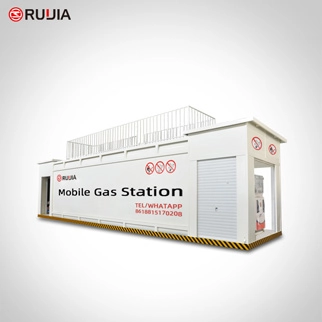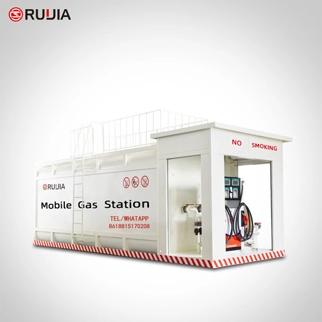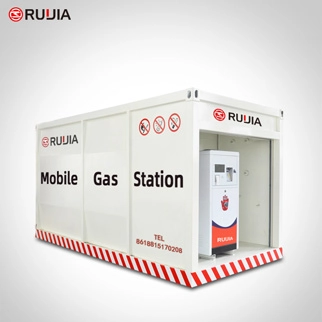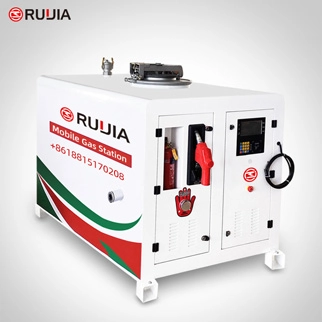- 20+ Years Of History
- 30+ Countries
- 50000 Yearly Production
What Is a Mobile Gas Station?
A mobile gas station is a vehicle or trailer equipped with fuel storage tanks, pumps, and dispensing systems designed to deliver fuel to customers in locations where traditional gas stations are unavailable or inaccessible. Unlike fixed fueling stations, which are stationary and require vehicles to travel to them, mobile gas stations bring fuel directly to the customer. This innovative approach addresses a wide range of challenges, from rural accessibility to emergency response, and has become an essential part of the modern fueling industry.
Mobile gas stations are not a new concept, but their role has evolved significantly with advancements in technology, environmental regulations, and changing consumer demands. Today, they serve as a flexible, efficient, and often cost-effective solution for refueling vehicles in remote areas, disaster zones, industrial sites, and even urban environments. This article explores the definition, components, benefits, challenges, and future of mobile gas stations, highlighting their importance in the global energy landscape.
The Concept and Evolution of Mobile Gas Stations
The idea of mobile fueling dates back to the early 20th century, when the rise of the automobile industry created a need for fuel delivery to areas without established gas stations. Initially, mobile gas stations were simple trucks equipped with small fuel tanks and manual pumps, used primarily for supplying fuel to military operations or remote construction sites. Over time, as fueling technology advanced, these mobile units became more sophisticated, incorporating electronic systems, automated dispensers, and safety mechanisms.
Today, mobile gas stations are a critical component of the fuel distribution network, serving both commercial and consumer needs. They are particularly valuable in regions with limited infrastructure, such as rural communities, developing countries, and disaster-stricken areas. By eliminating the need for permanent fueling stations, mobile gas stations reduce the environmental and economic costs associated with building and maintaining traditional facilities.
The evolution of mobile gas stations has also been driven by technological innovation. Modern units are equipped with GPS tracking, digital payment systems, and real-time fuel monitoring, making them more efficient and user-friendly. Additionally, the integration of alternative fuels, such as compressed natural gas (CNG) and hydrogen, has expanded the capabilities of mobile gas stations, enabling them to support the growing demand for cleaner energy solutions.
Components and Operation of a Mobile Gas Station
A mobile gas station is a self-contained unit that combines the functionality of a traditional fueling station with the flexibility of a vehicle. Its key components include:
1. Fuel Storage Tanks
The core of a mobile gas station is its fuel storage tanks, which are designed to hold various types of fuel, including gasoline, diesel, CNG, and even ethanol. These tanks are typically made of durable materials such as stainless steel or reinforced plastic to ensure safety and longevity. The size of the tanks varies depending on the intended use, with larger units capable of carrying thousands of gallons of fuel.
2. Pumps and Dispensers
Mobile gas stations are equipped with pumps and dispensers that allow fuel to be transferred from the storage tanks to vehicles. These systems are similar to those found in traditional gas stations, featuring high-pressure pumps and precision flow meters to ensure accurate fuel measurement. Some units also include multiple dispensers to accommodate different vehicle types and fuel requirements.
3. Safety Systems
Given the risks associated with handling flammable liquids, mobile gas stations are designed with robust safety features. These include anti-overfill systems to prevent spills, grounding systems to dissipate static electricity, and pressure relief valves to manage fuel pressure. Many units also have fire suppression systems and emergency shut-off mechanisms to minimize the risk of accidents.
4. Power and Electrical Systems
Mobile gas stations require a reliable power source to operate their pumps, dispensers, and electronic systems. Most units are powered by internal combustion engines or electric motors, with backup power systems to ensure continuous operation. Advanced models may also include solar panels or other renewable energy sources to reduce their environmental impact.
5. Control and Monitoring Systems
Modern mobile gas stations are equipped with digital control systems that allow operators to monitor fuel levels, track vehicle usage, and manage transactions. These systems often include touchscreens, keypads, and wireless connectivity for remote monitoring. Some units also feature GPS tracking to optimize routes and improve operational efficiency.
6. Transportation Infrastructure
Mobile gas stations are typically mounted on trucks, trailers, or specialized vehicles designed to withstand the rigors of long-distance travel. These vehicles are built with reinforced frames, suspension systems, and safety certifications to ensure stability and compliance with transportation regulations.
Benefits of Mobile Gas Stations
Mobile gas stations offer a range of advantages over traditional fueling stations, making them an attractive option for both consumers and businesses. Some of the key benefits include:
1. Accessibility in Remote Areas
One of the most significant advantages of mobile gas stations is their ability to reach remote or underserved areas where traditional fueling stations are scarce or nonexistent. This is particularly important in rural communities, isolated industrial sites, and disaster zones, where access to fuel can be a critical issue. By bringing fuel directly to these locations, mobile gas stations help ensure that vehicles, machinery, and emergency services remain operational.
2. Cost-Effectiveness
Operating a mobile gas station can be more cost-effective than building and maintaining a traditional fueling station. The absence of permanent infrastructure reduces initial investment and ongoing maintenance costs. Additionally, mobile units can be deployed strategically to meet demand, avoiding the need for overcapacity or underutilized facilities.
3. Flexibility and Scalability
Mobile gas stations are highly adaptable, allowing operators to adjust their services based on changing needs. For example, a mobile unit can be reconfigured to supply different types of fuel or relocated to a new location as required. This flexibility makes them ideal for temporary projects, seasonal operations, and emergency response efforts.
4. Emergency Response and Disaster Relief
In the event of natural disasters, such as hurricanes, earthquakes, or wildfires, traditional fueling stations may be damaged or inaccessible. Mobile gas stations play a crucial role in emergency response by providing fuel to rescue teams, medical vehicles, and affected communities. Their ability to operate in challenging conditions ensures that critical services can continue even when infrastructure is compromised.
5. Environmental and Economic Sustainability
Mobile gas stations can contribute to environmental sustainability by reducing the need for long-distance fuel transportation. By delivering fuel directly to the point of use, they minimize the carbon footprint associated with fuel distribution. Additionally, some mobile units are designed to use alternative fuels, such as CNG or hydrogen, further reducing emissions and supporting the transition to cleaner energy sources.
6. Support for Specialized Industries
Mobile gas stations are widely used in industries that require on-site fueling, such as mining, construction, and agriculture. These sectors often operate in remote locations where traditional fueling stations are impractical. By providing a reliable fuel source, mobile gas stations enhance productivity and reduce downtime for equipment and vehicles.
Challenges and Limitations of Mobile Gas Stations
Despite their many advantages, mobile gas stations also face several challenges and limitations that must be addressed to ensure their effectiveness and safety.
1. Regulatory Compliance
Mobile gas stations must comply with a wide range of regulations related to fuel storage, transportation, and safety. These regulations vary by country and region, requiring operators to navigate complex legal frameworks. For example, in the United States, the Department of Transportation (DOT) and the Environmental Protection Agency (EPA) impose strict guidelines on the design, operation, and maintenance of mobile fueling units.
2. Safety Risks
Handling and transporting fuel inherently carries risks, including the potential for spills, fires, and explosions. While modern mobile gas stations are equipped with advanced safety features, the risk of accidents remains a concern. Operators must implement rigorous safety protocols, including regular inspections, staff training, and emergency response plans, to mitigate these risks.
3. Operational Costs
Although mobile gas stations can be cost-effective in the long term, they require significant upfront investment in vehicles, fuel storage tanks, and equipment. Additionally, ongoing costs such as fuel procurement, maintenance, and staffing can add up, especially for large-scale operations. These expenses must be carefully managed to ensure profitability.
4. Environmental Impact
While mobile gas stations can reduce the environmental impact of fuel distribution, they are not without their own ecological challenges. The transportation of fuel by road contributes to greenhouse gas emissions, and the risk of fuel leaks or spills can harm local ecosystems. Operators must adopt sustainable practices, such as using eco-friendly fuels and implementing spill prevention measures, to minimize their environmental footprint.
5. Public Perception and Trust
Some consumers may be hesitant to use mobile gas stations due to concerns about quality, safety, and reliability. Building trust requires transparency, consistent service, and adherence to industry standards. Operators must invest in marketing and customer education to address these concerns and promote the benefits of mobile fueling.
Technological Innovations in Mobile Gas Stations
Advancements in technology have significantly enhanced the capabilities of mobile gas stations, making them more efficient, safe, and user-friendly. Key innovations include:
1. Digital Fuel Management Systems
Modern mobile gas stations are equipped with digital fuel management systems that allow operators to monitor fuel levels, track usage, and manage inventory in real time. These systems use sensors, GPS, and cloud-based platforms to provide data-driven insights, helping operators optimize their operations and reduce waste.
2. Contactless Payment Solutions
To improve convenience and reduce the risk of theft, many mobile gas stations now offer contactless payment options, such as mobile wallets, credit cards, and RFID tags. These systems enable customers to pay quickly and securely, streamlining the refueling process.
3. Automated Dispensing Systems
Automated dispensing systems are becoming increasingly common in mobile gas stations, allowing for faster and more accurate fuel delivery. These systems use programmable logic controllers (PLCs) and IoT-enabled devices to regulate fuel flow and prevent overfilling.
4. Alternative Fuel Integration
As the demand for cleaner energy grows, mobile gas stations are being adapted to accommodate alternative fuels. For example, some units are designed to dispense CNG, hydrogen, and biofuels, supporting the transition to a more sustainable energy future.
5. Remote Monitoring and Maintenance
Advanced mobile gas stations are equipped with remote monitoring systems that allow operators to track performance, detect malfunctions, and schedule maintenance from a central location. This reduces downtime and ensures that the unit remains operational at all times.
Case Studies and Real-World Applications
Mobile gas stations have been successfully implemented in a variety of settings, demonstrating their versatility and effectiveness. Here are a few notable examples:
1. Rural Communities in Developing Countries
In many developing countries, access to fuel is limited, particularly in rural areas. Mobile gas stations have been introduced to provide fuel to farmers, fishermen, and other local businesses. For instance, in parts of Africa, mobile units are used to supply diesel to agricultural machinery, improving productivity and reducing reliance on imported fuel.
2. Disaster Response in the United States
During natural disasters, such as Hurricane Katrina and the California wildfires, mobile gas stations played a critical role in supporting emergency efforts. These units provided fuel to rescue teams, medical vehicles, and affected communities, ensuring that essential services could continue despite damaged infrastructure.
3. Industrial and Construction Sites
Mobile gas stations are widely used in the construction and mining industries, where access to fuel is often limited. For example, in Australia, mobile units are deployed to supply fuel to remote mining operations, reducing the need for costly fuel transportation and improving operational efficiency.
4. Military and Defense Operations
The military has long relied on mobile gas stations to support its operations. These units are used to refuel vehicles, aircraft, and equipment in forward-deployed locations, ensuring that troops have the necessary resources to carry out their missions.
The Future of Mobile Gas Stations
As the energy landscape continues to evolve, mobile gas stations are expected to play an even greater role in the future of fuel distribution. Several trends and innovations are likely to shape their development:
1. Integration with Electric Vehicle (EV) Charging
With the rise of electric vehicles, mobile gas stations may evolve to include EV charging capabilities. This could involve converting existing units to supply electricity or developing new mobile charging stations that can serve both traditional and electric vehicles.
2. Sustainable Fuel Solutions
The increasing focus on sustainability is driving the adoption of alternative fuels, such as hydrogen and biofuels. Mobile gas stations are well-positioned to support this transition by providing on-demand fueling for clean energy vehicles.
3. Smart and Connected Technologies
Future mobile gas stations will likely incorporate more advanced technologies, such as artificial intelligence (AI), blockchain, and 5G connectivity. These innovations will enable real-time data sharing, predictive maintenance, and enhanced customer experiences.
4. Expansion into Urban Markets
While mobile gas stations have traditionally been used in rural and remote areas, there is growing interest in deploying them in urban environments. This could address fuel shortages in densely populated cities or provide convenient refueling options for delivery vehicles and taxis.
5. Regulatory and Environmental Standards
As governments implement stricter environmental regulations, mobile gas stations will need to adopt cleaner technologies and practices. This may include using electric or hybrid vehicles for fuel delivery, reducing emissions, and minimizing the environmental impact of fuel storage and transportation.
Conclusion
Mobile gas stations represent a dynamic and innovative solution to the challenges of fuel distribution in the modern world. By bringing fuel directly to customers, they address gaps in traditional infrastructure, support emergency response efforts, and provide cost-effective alternatives for specialized industries. Despite the challenges they face, such as regulatory compliance and safety risks, mobile gas stations continue to evolve through technological advancements and sustainable practices. As the demand for flexible and reliable fueling solutions grows, mobile gas stations are poised to play an increasingly important role in the global energy sector. Whether serving remote communities, disaster zones, or industrial sites, these mobile units exemplify the power of innovation in meeting the diverse needs of today’s fueling landscape.







